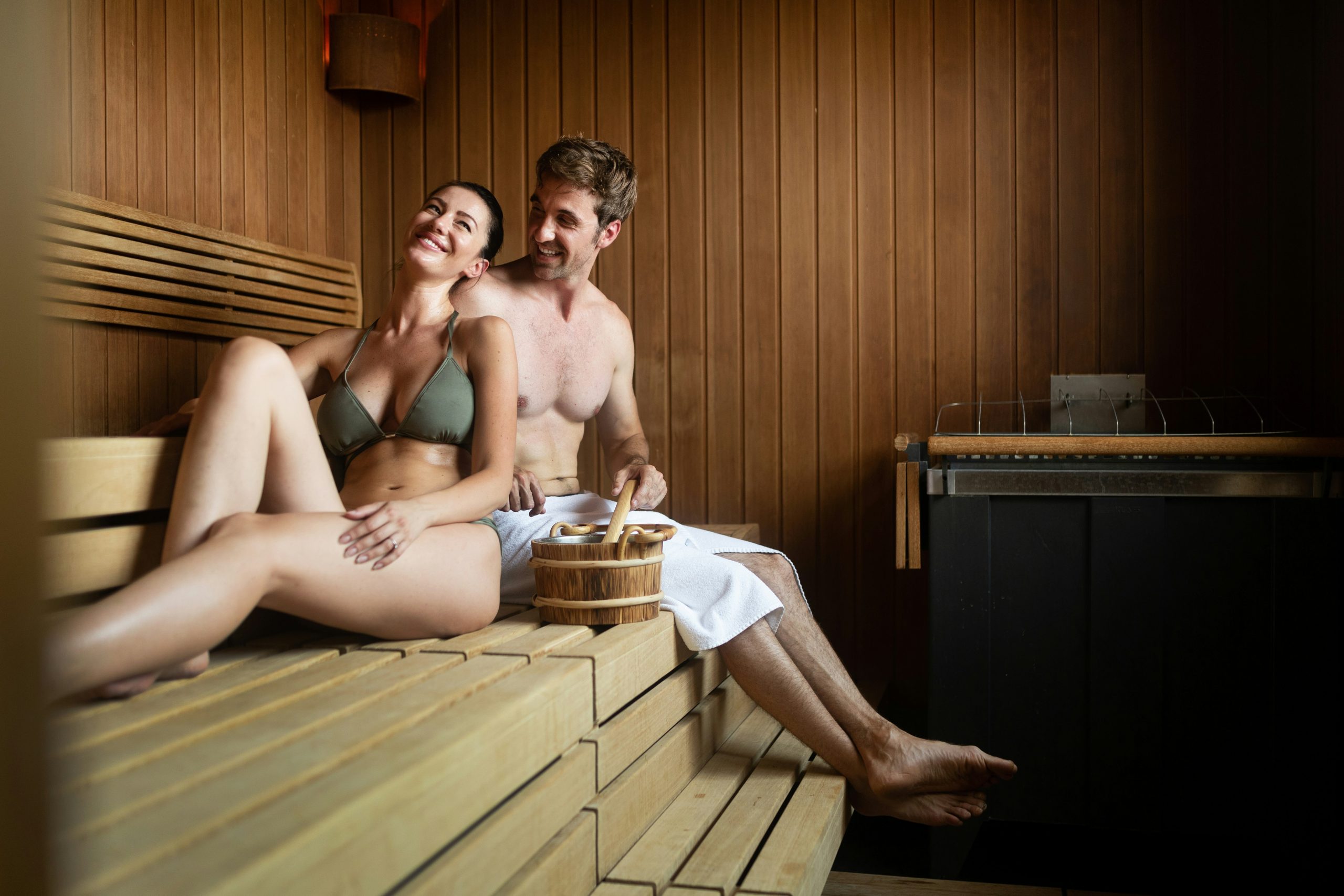Regular sauna can calm inflammatory pathways and support heart health. Infrared is not proven better than a traditional Finnish sauna. The best choice is the one you will use often and safely.
“Think of sauna as light cardio for your blood vessels. Short heat sessions, done often, can nudge blood pressure down and help you recover between workouts.”
The relationship
A sauna is a heated room that raises skin and core temperature to trigger sweating and a rise in heart rate in a controlled way. Traditional Finnish rooms heat the air. Infrared rooms heat the body with light that passes into tissue.
Large human cohorts from Finland link frequent sauna use to lower risks of sudden cardiac death, fatal coronary disease, and all-cause mortality. In one study of 2,315 men enrolled between 1984 and 1989, four to seven sessions a week linked to a 63% lower risk of sudden cardiac death compared with one session a week. Hazard ratio 0.37 with 95% CI 0.18 to 0.75. Risks of fatal heart disease and all-cause death were also lower in a graded fashion with more sessions [1]. A follow-up analysis that included women reported lower cardiovascular mortality and better risk prediction when sauna habits were added to standard risk factors [2].
Inflammation matters for lifespan and heart events. A Finnish analysis tied frequent sauna use to lower odds of high hsCRP. hsCRP means high-sensitivity C-reactive protein, a blood marker of systemic inflammation. In men followed for a median of 27.8 years, frequent sessions seemed to blunt the higher death risk linked to elevated hsCRP [3].
How it works
Vessel relaxation and arterial stiffness
Arterial stiffness means reduced flexibility of large arteries. It raises workload on the heart. In a clinical trial with 102 adults who had at least one cardiovascular risk factor, a single 30-minute Finnish sauna at 73 °C with 10 to 20% humidity dropped carotid-femoral pulse wave velocity from 9.8 to 8.6 meters per second. Systolic pressure fell from 137 to 130 mmHg and diastolic from 82 to 75 mmHg. Values stayed lower at 30 minutes after the session [4]. Reviews support improved endothelial function, which is the ability of the vessel lining to widen on demand [5].
Autonomic balance and heart workload
The autonomic nervous system controls heart rate, vessel tone, and sweating without conscious effort. Sauna exposure shifts this balance toward lower vascular resistance after cooling. That eases the load on the heart. The 102-person trial above showed lower blood pressure and improved stiffness measures soon after a standard session, which points to this mechanism in real time [4].
Inflammation signals
Inflammation is the body’s immune response to injury or stress. It protects in the short term but can harm when chronic. Observational data show an inverse link between frequent sauna use and hsCRP levels. People who used the sauna often had lower odds of high hsCRP than rare users [6]. In long-term follow-up, frequent sauna use also seemed to offset the higher mortality seen with elevated hsCRP [3].
Fitness and metabolism
Heat exposure can raise heart rate to levels seen with easy to moderate exercise. In a randomized trial of 47 adults with low activity and at least one risk factor, eight weeks of guideline exercise plus a 15-minute sauna after each session beat exercise alone. Cardiorespiratory fitness rose by 2.7 mL per kg per minute more. Systolic pressure was 8 mmHg lower and total cholesterol was lower than exercise alone [7]. Reviews of cardiometabolic effects suggest blood pressure drops near 4 mmHg on average with repeated heat sessions, though study sizes are small and methods vary [7,8].
Traditional vs infrared
Infrared sauna warms tissue with infrared light at lower air temperatures. Traditional Finnish rooms heat the air to higher temperatures. Evidence for heart and longevity outcomes comes mostly from Finnish dry saunas. Trials of far-infrared or Waon therapy at about 60 °C show symptom gains in heart failure and small drops in blood pressure, yet these are short-term and in select patients [9–12]. Head-to-head tests are lacking. Based on current human data, infrared is not proven superior to traditional for health outcomes [5,9].
Conditions linked to it
Cardiovascular mortality. In men and women, frequent sessions linked to lower cardiovascular death. In one cohort, four to seven sessions a week showed a hazard ratio of 0.23 for cardiovascular mortality versus one session a week. Ninety five percent CI 0.11 to 0.47 [2].
Sudden cardiac death. In the same Finnish data set focused on men, the hazard ratio for sudden cardiac death was 0.37 for four to seven sessions a week versus one. The trend was graded by session length and frequency [1].
Hypertension. People with frequent sauna use had lower risk of incident high blood pressure over time in cohort research [13]. A small randomized study in untreated hypertension also reported lower 24-hour systolic pressure after sauna combined with exercise compared with control arms [14].
Stroke. A prospective study in 1,628 Finnish adults reported lower stroke risk with four to seven sessions a week compared with one session a week. Findings held after adjustment for major risks [15].
Heart failure symptoms. Trials of Waon therapy in patients with heart failure report improved clinical status, lower natriuretic peptides, and fewer events in selected settings. These data come from small samples and short time frames [10–12].
Limitations. Many links come from one country and one cultural pattern of dry sauna use. Observational cohorts cannot prove cause and effect. Trials in heart failure are short and small. Head-to-head tests of infrared and traditional are scarce. Results may not generalize to all ages, ethnic groups, or heat settings [2,5,9–12].
Symptoms and signals
- Good signs: you feel warm but clear headed. Breathing is easy. Heart rate settles within minutes after you exit. Sleep and recovery feel better the next day. Blood pressure trends a few points lower over weeks if you track it [4,7].
- Warning signs: dizziness on standing, pounding headache, chest pain, nausea, cramps, or confusion. Stop the session and cool down.
- Hydration flags: dark urine, dry mouth, or drop in body weight over 1% across a session. Drink water and consider a pinch of salt with longer heat days.
- Medication flags: nitrates, alpha-blockers, high dose diuretics, and recent alcohol raise fainting risk in the heat [16,17].
- Fertility flags: men trying to conceive should avoid frequent high heat. Human studies show reversible drops in sperm count and motility after repeated sauna exposure. Counts tend to recover after several weeks to months off heat [18–21].
What to do about it
- Test and screen. Check resting blood pressure and any heart symptoms before starting a new routine. If you have unstable chest pain, recent heart attack, or severe aortic stenosis, skip sauna unless cleared by your cardiology team [16,17]. If pregnant, ask your obstetric clinician for guidance. If you plan a pregnancy, avoid frequent high heat until after conception due to sperm sensitivity [18–21].
- Build a practical routine. Start with 10 to 15 minutes per session at a comfortable setting. Aim for two to three days a week. If you tolerate it well, progress toward four to seven short sessions per week as used in Finnish cohorts. Cool down for at least the same time you heated. Drink water. Combine post-workout heat with easy days to enhance recovery. Choose the room you can access often, whether traditional or infrared. The frequency pattern is the lever tied to the strongest human data on sauna health benefits [1,2,4,7].
- Monitor and adjust. Track systolic and diastolic pressure, weekly body weight, and sleep. If systolic pressure falls by about 5 to 8 mmHg over several weeks and you feel fine, you are likely on track. If you feel faint or get headaches, shorten sessions, lower heat, or take an extra rest day [4,7].
Myth vs Fact
- Myth: Infrared is better than traditional for health. Fact: Trials and cohorts that link sauna to lower cardiovascular risk come mainly from traditional Finnish rooms. Infrared studies are small and short. No head-to-head data show superiority [2,5,9–12].
- Myth: You need very long sessions to help longevity. Fact: Benefits track with weekly frequency. Fifteen to twenty minutes per visit worked in trials and cohorts. More days per week linked to lower risk [1,2,7].
- Myth: Sauna “detoxes” heavy metals and that is the main effect. Fact: Main effects are vascular and autonomic. Claims about detox lack strong human trials [5,9].
- Myth: Heart patients must avoid sauna. Fact: Stable coronary disease or controlled heart failure can use sauna with care. Certain conditions remain off-limits and alcohol raises risk [16,17].
Bottom line
Regular sauna use links to lower inflammation signals and better cardiovascular outcomes in human studies. Traditional Finnish rooms hold the strongest evidence. Infrared can work, yet it is not proven superior. Start low, go often, and follow basic safety rules. The best sauna for you is the one you will use, week after week, without problems.
References
- Laukkanen T, Khan H, Zaccardi F, Laukkanen JA. Association Between Sauna Bathing and Fatal Cardiovascular and All-Cause Mortality Events. JAMA Internal Medicine. 2015;175(4):542-548. PMID: 25705824.
- Laukkanen T, Kunutsor S, Kauhanen J, Laukkanen JA. Sauna bathing is associated with reduced cardiovascular mortality and improves risk prediction in men and women: a prospective cohort study. BMC Medicine. 2018;16:219. PMID: 30486813.
- Kunutsor SK, Jae SY, Kurl S, Kauhanen J, Laukkanen JA. Inflammation, sauna bathing, and all-cause mortality in middle-aged and older Finnish men: a cohort study. European Journal of Epidemiology. 2022;37(12):1225-1231. PMID: 36255556.
- Laukkanen T, Kunutsor SK, Zaccardi F, et al. Acute effects of sauna bathing on cardiovascular function. Journal of Human Hypertension. 2018;32(2):129-138. PMID: 29269746.
- Laukkanen JA, Laukkanen T, Kunutsor SK. Cardiovascular and Other Health Benefits of Sauna Bathing: A Review of the Evidence. Mayo Clinic Proceedings. 2018;93(8):1111-1121. PMID: 30077204.
- Laukkanen T, Laukkanen JA, Kurl S, et al. Sauna bathing and systemic inflammation. European Journal of Epidemiology. 2018;33(5):351-353. PMID: 29209938.
- Lee E, Laukkanen JA, Thijssen DHJ, et al. Effects of regular sauna bathing in conjunction with exercise on cardiovascular function: a multi-arm randomized controlled trial. American Journal of Physiology. Regulatory, Integrative and Comparative Physiology. 2022;323(3):R254-R265. PMID: 35785965.
- Henderson KN, et al. The Cardiometabolic Health Benefits of Sauna Exposure in Individuals with High-Stress Occupations. International Journal of Environmental Research and Public Health. 2021;18(3):934. PMCID: PMC7908414.
- Beever R. Far-infrared saunas for treatment of cardiovascular risk factors: summary of published evidence. Canadian Family Physician. 2009;55(7):691-696. PMCID: PMC2718593.
- Kihara T, et al. Waon therapy improves the prognosis of patients with chronic heart failure. Journal of Cardiology. 2009;53(2):214-218. PMID: 19304125.
- Tei C, et al. Waon Therapy for Managing Chronic Heart Failure. Circulation Journal. 2016;80(5):1114-1121. PMID: 27001189.
- Fujita S, et al. Effect of Waon therapy on oxidative stress in chronic heart failure. Circulation Journal. 2011;75(2):348-356. PMID: 21173495.
- Zaccardi F, Laukkanen T, Kunutsor SK, Willeit P, Laukkanen JA. Sauna Bathing and Incident Hypertension: A Prospective Cohort Study. American Journal of Hypertension. 2017;30(11):1120-1125. PMID: 28633297.
- Gayda M, et al. Effects of Sauna Alone and Postexercise Sauna Baths on Ambulatory Blood Pressure in Hypertensive Patients. Blood Pressure Monitoring. 2012;17(3):111-115. PMCID: PMC8108777.
- Kunutsor SK, et al. Sauna bathing reduces the risk of stroke in Finnish men and women: A prospective cohort study. Neurology. 2018;90(22):e1937-e1944. PMID: 29720543.
- Hannuksela ML, Ellahham S. Benefits and risks of sauna bathing. American Journal of Medicine. 2001;110(2):118-126. PMID: 11165553.
- Keast ML, et al. The Finnish sauna bath and its use in patients with cardiovascular disease. Canadian Family Physician. 2000;46:1241-1245. PMID: 10955262.
- Garolla A, et al. Seminal and molecular evidence that sauna exposure affects human spermatogenesis. Human Reproduction. 2013;28(4):877-885. PMID: 23411620.
- Saikhun J, et al. Effects of sauna on sperm movement characteristics of normal men. International Journal of Andrology. 1998;21(6):358-363. PMID: 9972494.
- Brown-Woodman PD, et al. The effect of a single sauna exposure on spermatozoa. International Journal of Andrology. 1984;7(1):59-67. PMID: 6476971.

